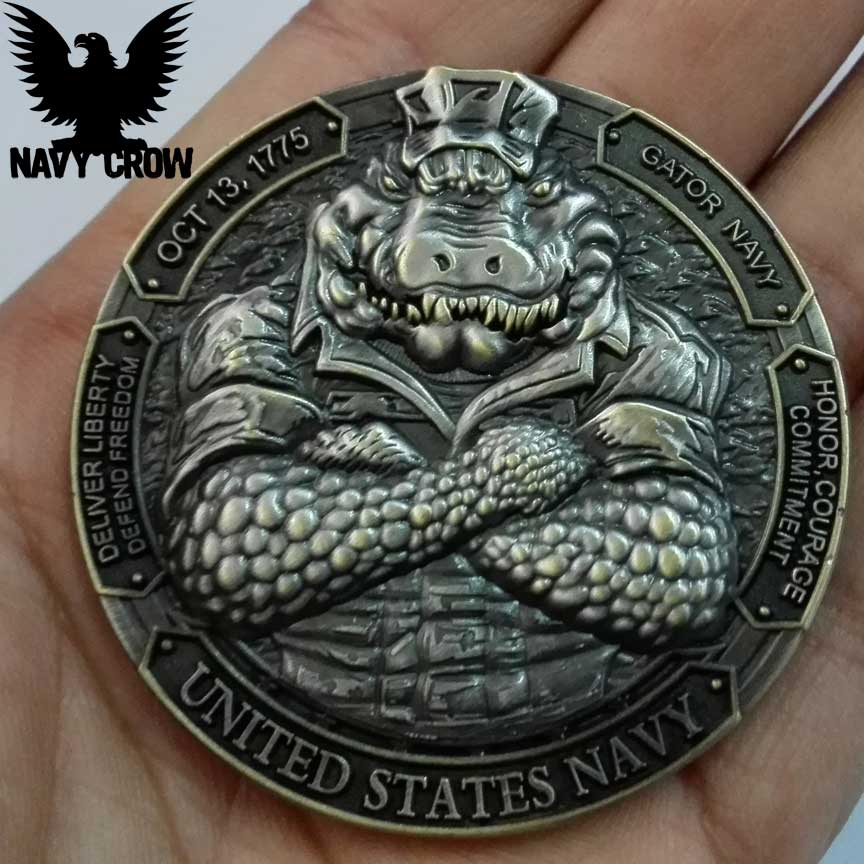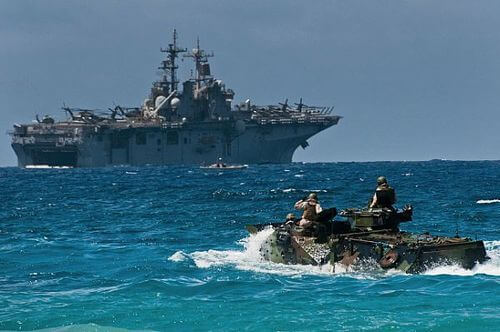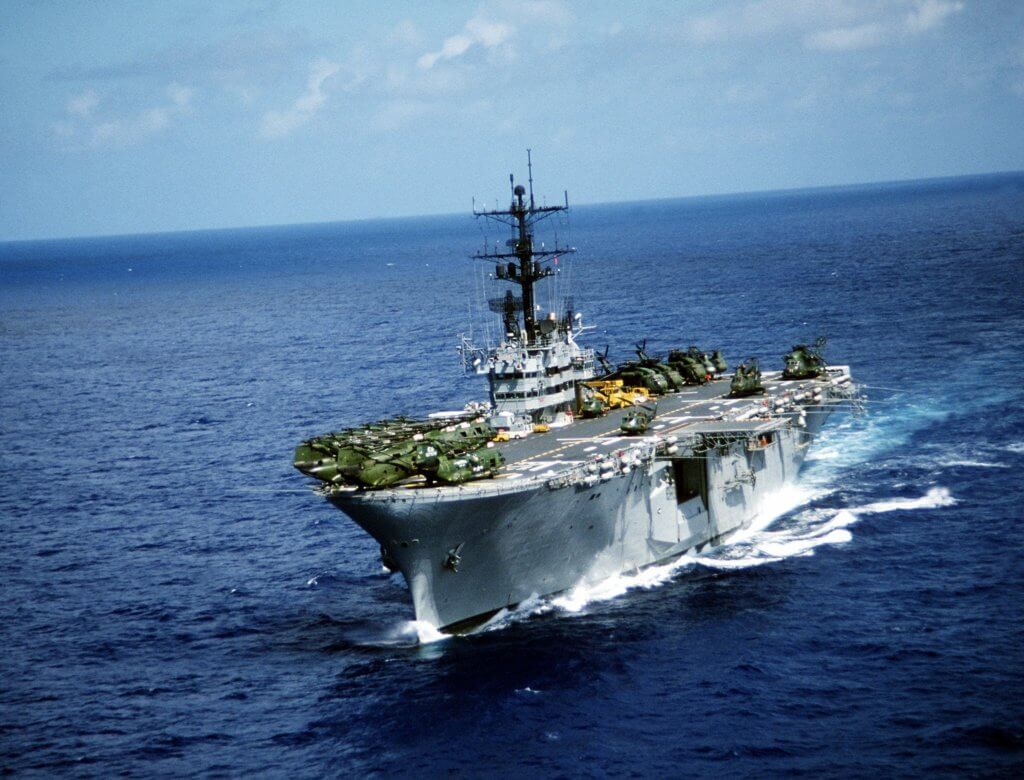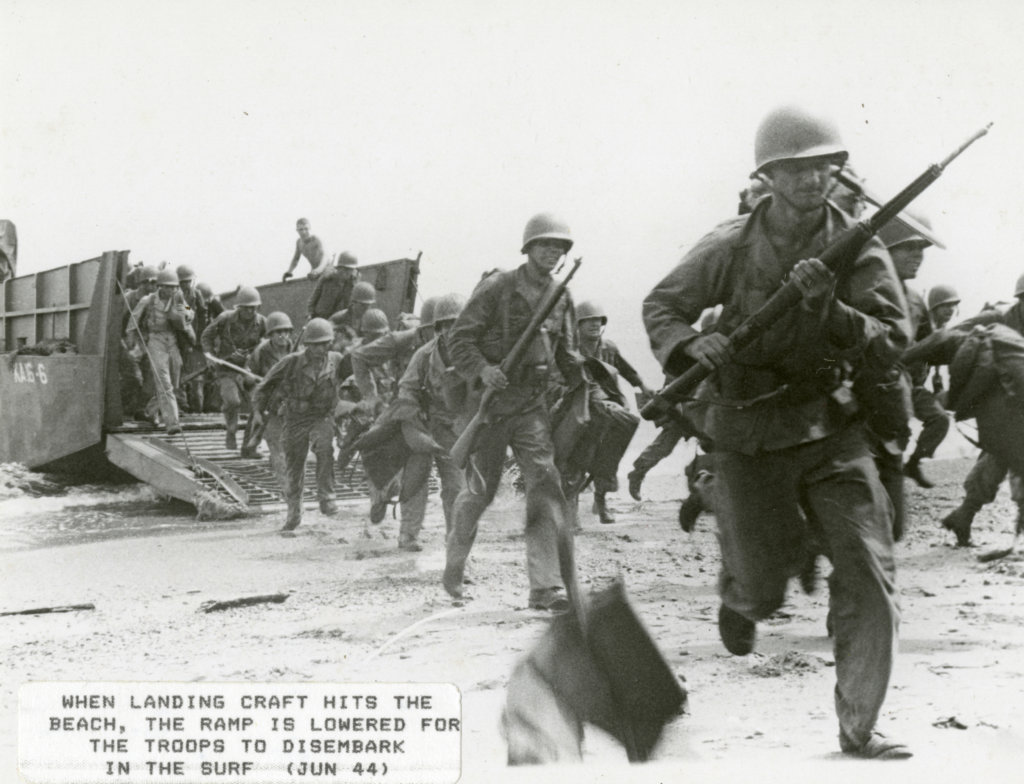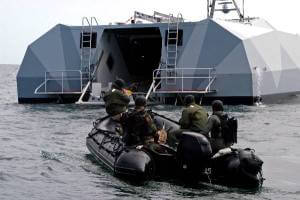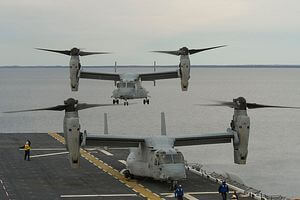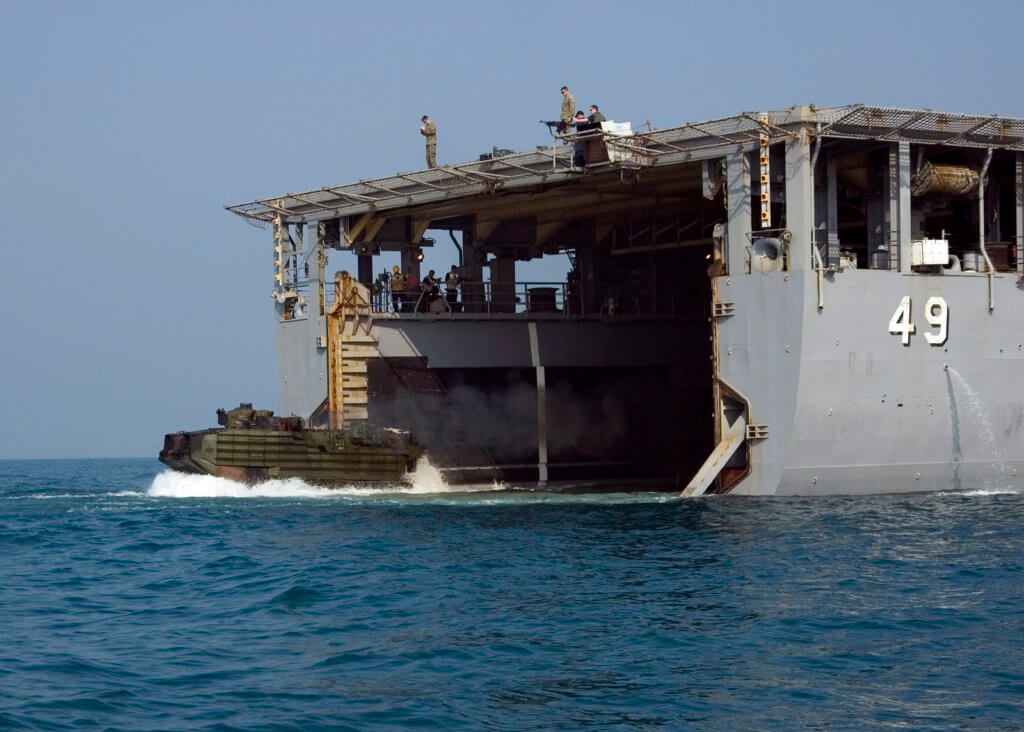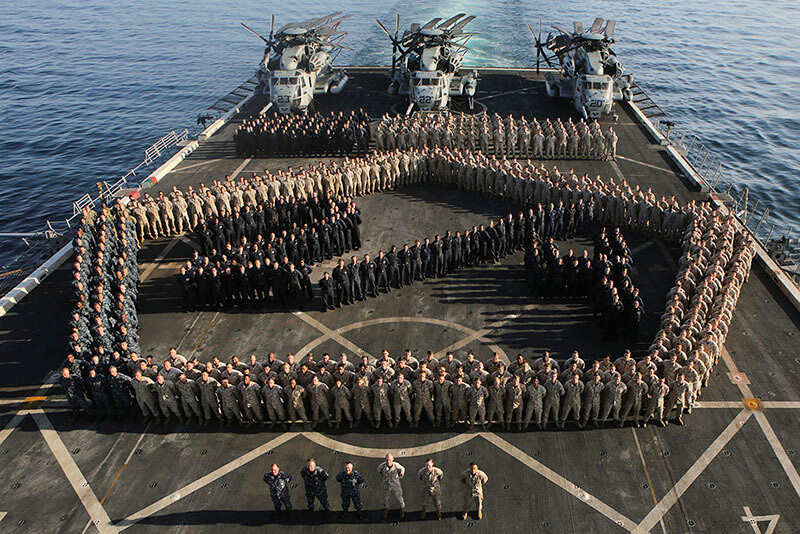Gator Navy Challenge Coin
At 7:55 a.m. (Pearl Harbor time) on the morning of Sunday, December 7, 1941, the U.S. Navy was without a single oceangoing ship capable of discharging a cargo of big tanks or other heavy equipment onto a beach without the aid of piers or cranes. The events of that moment would change that situation. Amphibious forces, a.k.a. Gator Navy
In the Pacific Gator Navy would wrestle island by island away from the Japanese and in Europe recover Europe from Hitler’s grip. Since then amphibious forces have played an important role in U.S. Navy operations. The Gator Navy was about to be born!
What is an Amphib?
An amphibious warfare ship is a warship employed to land and support ground forces, such as Marines, on enemy territory during an amphibious assault. The largest fleet of these types is operated by the United States Navy,including the Tarawa-class amphibious assault ships dating back to the 1970s and the newer and larger Wasp class ships that debuted in 1989. These are colloquially known throughout the Navy as “Gator Freighters” or “Gator Navy”, playing on the Amphibious nature of Alligators.
Specialized shipping can be divided into two types, most crudely described as ships and craft. In general the ships carry the troops from the port of embarkation to the drop point for the assault and the craft carry the troops from the ship to the shore. Amphibious assaults taking place over short distances can also involve the shore-to-shore technique where landing craft go directly from the port of embarkation to the assault point.
The History of the Gator Freighters and How the Gator Navy Came to be
In the days of sail, ship’s boats were used as landing craft. These rowing boats were sufficient, if inefficient, in an era when Marines were effectively light infantry, participating mostly in small-scale campaigns in far-flung colonies against less well-equipped indigenous opponents.
During World War I, the mass mobilization of troops equipped with rapid-fire weapons quickly rendered such boats obsolete. Initial landings during the Gallipoli campaign took place in unmodified rowing boats that were extremely vulnerable to attack from the Turkish shore defenses.
During the interwar period, the combination of the negative experience at Gallipoli and economic stringency contributed to the delay in procuring equipment and adopting a universal doctrine for amphibious operations in the Royal Navy. The United States revived and experimented in their approach to amphibious warfare between 1913 to mid-1930s, when the United States Navy and United States Marine Corps became interested in setting up advanced bases in opposing countries during wartime; the prototype advanced base force officially evolved into the Fleet Marine Force (FMF) in 1933.
Gators in the Second World War
In the run up to WWII, many specialized landing craft, both for infantry and vehicles, were developed. In November 1938, the British proposed a new type of landing craft. Its specifications were to weigh less than ten tons, to be able to carry the thirty-one men of a British Army platoon and five engineers and to be so shallow drafted as to be able to land them, wet only up to their knees, in eighteen inches of water All of these specifications made the Landing Craft Assault; a separate set of requirements were laid down for a vehicle and supplies carrier, although previously the two roles had been combined in the Motor Landing Craft.
The Landing Craft Assault remained the most common British and Commonwealth landing craft of World War II, and the humblest vessel admitted to the books of the Royal Navy on D-Day. The Landing Craft Infantry was a stepped up amphibious assault ship, developed in response to a British request for a vessel capable of carrying and landing substantially more troops than the smaller Landing Craft Assault (LCA). The result was a small steel ship that could land 200 troops, traveling from rear bases on its own bottom at a speed of up to 15 knots. The original British design was envisioned as being a “one time use” vessel which would simply ferry the troops across the English Channel, and were considered an expendable vessel. As such, no troop sleeping accommodations were placed in the original design. This was changed shortly after initial use of these ships, when it was discovered that many missions would require overnight accommodations.
Specialized vehicle landing craft – Gators that swim and crawl
A further development was the Landing Ship, Tank designation, built to support amphibious operations by carrying significant quantities of vehicles, cargo, and landing troops directly onto an unimproved shore. The British evacuation from Dunkirk in 1940 demonstrated that the Allies needed relatively large, ocean-going ships capable of shore-to-shore delivery of tanks and other vehicles in amphibious assaults upon the continent of Europe. The first purpose-built LST design was HMS Boxer. To carry 13 Churchill infantry tanks, 27 vehicles and nearly 200 men (in addition to the crew) at a speed of 18 knots, it could not have the shallow draught that would have made for easy unloading. As a result, each of the three (Boxer, Bruiser, and Thruster) ordered in March 1941 had a very long ramp stowed behind the bow doors.
In November 1941, a small delegation from the British Admiralty arrived in the United States to pool ideas with the United States Navy‘s Bureau of Ships with regard to development of ships and also including the possibility of building further Boxers in the US. During this meeting, it was decided that the Bureau of Ships would design these vessels. The LST(2) design incorporated elements of the first British LCTs from their designer, Sir Rowland Baker, who was part of the British delegation. This included sufficient buoyancy in the ships’ sidewalls that they would float even with the tank deck flooded. The LST(2) gave up the speed of HMS Boxer at only 10 knots but had a similar load while drawing only 3 feet forward when beaching.
Congress provided the authority for the construction of LSTs along with a host of other auxiliaries, destroyer escorts, and assorted landing craft. The enormous building program quickly gathered momentum. Such a high priority was assigned to the construction of LSTs that the previously laid keel of an aircraft carrier was hastily removed to make room for several LSTs to be built in her place. The keel of the first LST was laid down on 10 June 1942 at Newport News, Va., and the first standardized LSTs were floated out of their building dock in October. Twenty-three were in commission by the end of 1942. Lightly armored, they could steam cross the ocean with a full load on their own power, carrying infantry, tanks and supplies directly onto the beaches. Together with 2,000 other landing craft, the LSTs gave the troops a protected, quick way to make combat landings, beginning in summer 1943.
Other Kinds of Gators
The Landing Ship Dock, came as a result of a British requirement for a vessel that could carry large landing craft across the seas at speed. The first LSD came from a design by Sir Roland Baker and was an answer to the problem of launching small craft rapidly. The Landing Ship Stern Chute, which was a converted train ferry, was an early attempt. Thirteen Landing Craft Mechanized (LCM) could be launched from these ships down the chute. The Landing Ship Gantry was a converted tanker with a crane to transfer its cargo of landing craft from deck to sea – 15 LCM in a little over half an hour.
This Gator design was developed and built in the US for the USN and the Royal Navy. The LSD could carry 36 LCM at 16 knots. It had a large open compartment at the back. Opening a stern door and flooding special compartments opened this area to the sea so that LCI-sized vessels could enter or leave. It took one and a half hours for the dock to be flooded down and two and half to pump it out. When flooded they could also be used as docks for repairs to small craft.
Due to their small size, most amphibious ships were not given names and were just given serial numbers, for example, LCT 304. The LSTs were an exception to this, since they were similar in size to a small cruiser. In addition, three British-built LSTs were named: HMS Boxer, HMS Bruiser and HMS Thruster; these were all larger than the U.S. design and had proper funnels.
Early Cold War Gator Navy Developments
Despite all the progress that was seen during World War II, there were still fundamental limitations in the types of coastline that were suitable for assault. Beaches had to be relatively free of obstacles, and have the right tidal conditions and the correct slope. However, the development of the helicopter fundamentally changed the equation.
The first use of helicopters in an gator operations came during the Anglo–French–Israeli invasion of Egypt in 1956 (the Suez War). Two British light fleet carriers were pressed into service to carry helicopters, and a battalion-sized airborne assault was made. Two of the other carriers involved, Bulwark and Albion, were converted in the late 1950s into dedicated “commando carriers“.
The US Navy built five Iwo Jima-class landing platform helicopter vessels in the 1950s and 1960s, and various converted fleet and escort carriers for the purpose of providing a helicopter amphibious assault capability. The first of the type envisaged was the escort aircraft carrier Block Island, which never actually saw service as an amphibious assault ship. Delays in the construction of the Iwo Jima class saw other conversions made as a stopgap measure; three Essex-class aircraft carriers (Boxer, Princeton, and Valley Forge) and one Casablanca-class escort carrier (Thetis Bay) were converted into Boxer- and Thetis Bay-class amphibious assault vessels. Helicopter amphibious assault techniques were developed further by American forces in the Vietnam War and refined during training exercises.
The Tarawa and Wasp class types resemble aircraft carriers. However, the role of an amphibious assault ship is fundamentally different from that of an aircraft carrier. Its aviation facilities are not to support strike or air defense aircraft, but for hosting helicopters to support forces ashore.
Future Gator Navy Developments
One of the most recent innovations is the LCAC (Landing Craft Air Cushioned). These large hovercraft further expand the range of conditions under which an amphibious assault can take place and increase the speed of transfer of assets from ship to shore. Ground effect vehicles, which straddle the line between aircraft and ship, have also been proposed for the role in the past.
Amphibious assault submarines, while proposed during the 1950s, and almost brought to actual construction by the Soviet Union in the 1960s, are currently not being designed. However, if the predictions of military experts such as John Keegan or others hold true, and surface shipping becomes extremely dangerous during future wars of evenly matched powers (due to satellite reconnaissance and anti-ship missiles), then transport and amphibious assault submarines might deserve another look.

Gator Navy platforms: Hull classification symbol § Amphibious warfare type
- LHA: Landing Helicopter Assault (USS Tarawa class) Surface Sailors
- LHD: Landing Helicopter Dock (USS Wasp class)
- LPH: Landing Platform Helicopter (Iwo Jima class)
- LPD: Landing Platform Dock (San Antonio-class)
- LSD: Landing Ship Dock
- LSI: Landing Ship, Infantry was previously designated as Landing Craft, Infantry
- LSL: Landing Ship Logistics
- LSM: Landing Ship Medium
- LST: Landing Ship Tank
- LCC: Amphibious Command Ship, unrelated to the Landing Craft, Control (LCC)
- AGF: Auxiliary Command Ship
- AKA/LKA: Attack cargo ship
- AP/APA/LPA: Auxiliary Personnel Assault
- ARL: Landing Craft Repair Ship (USS Achelous (ARL-1) class)




